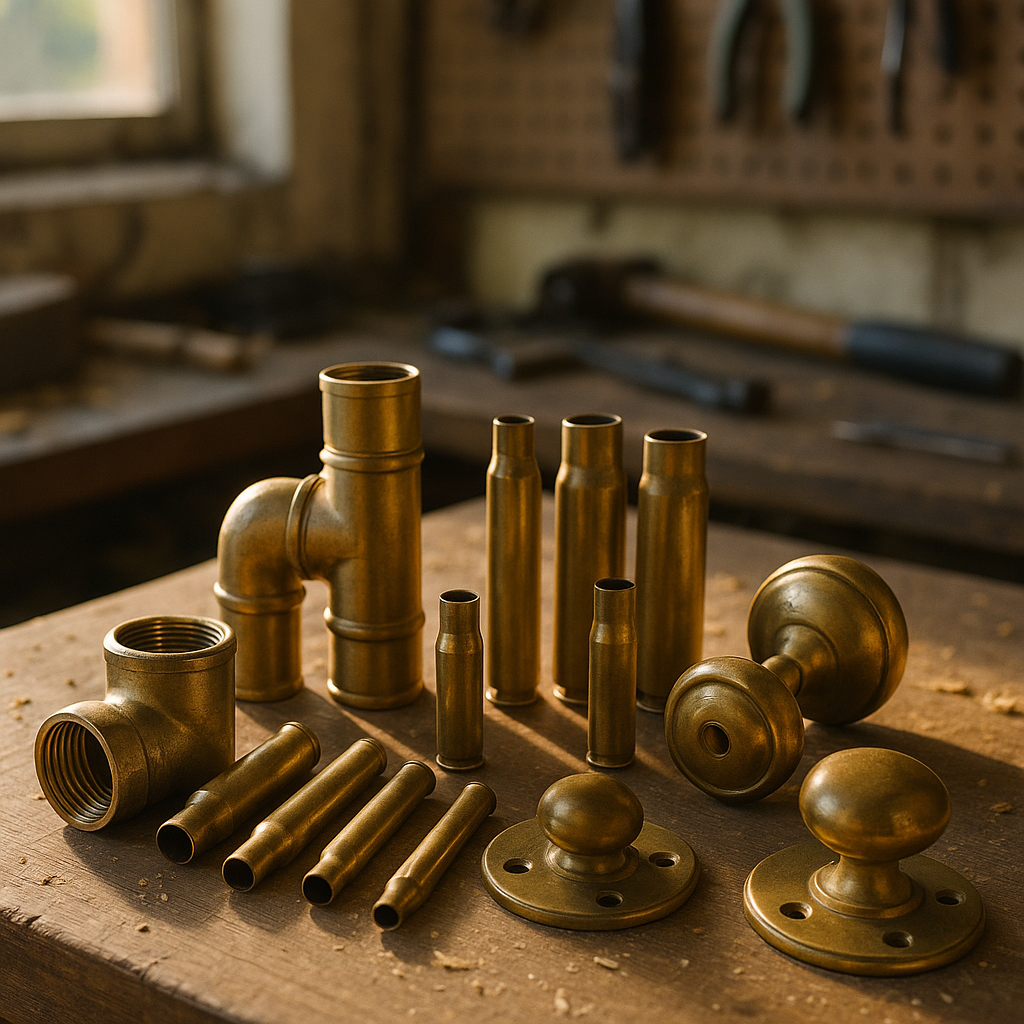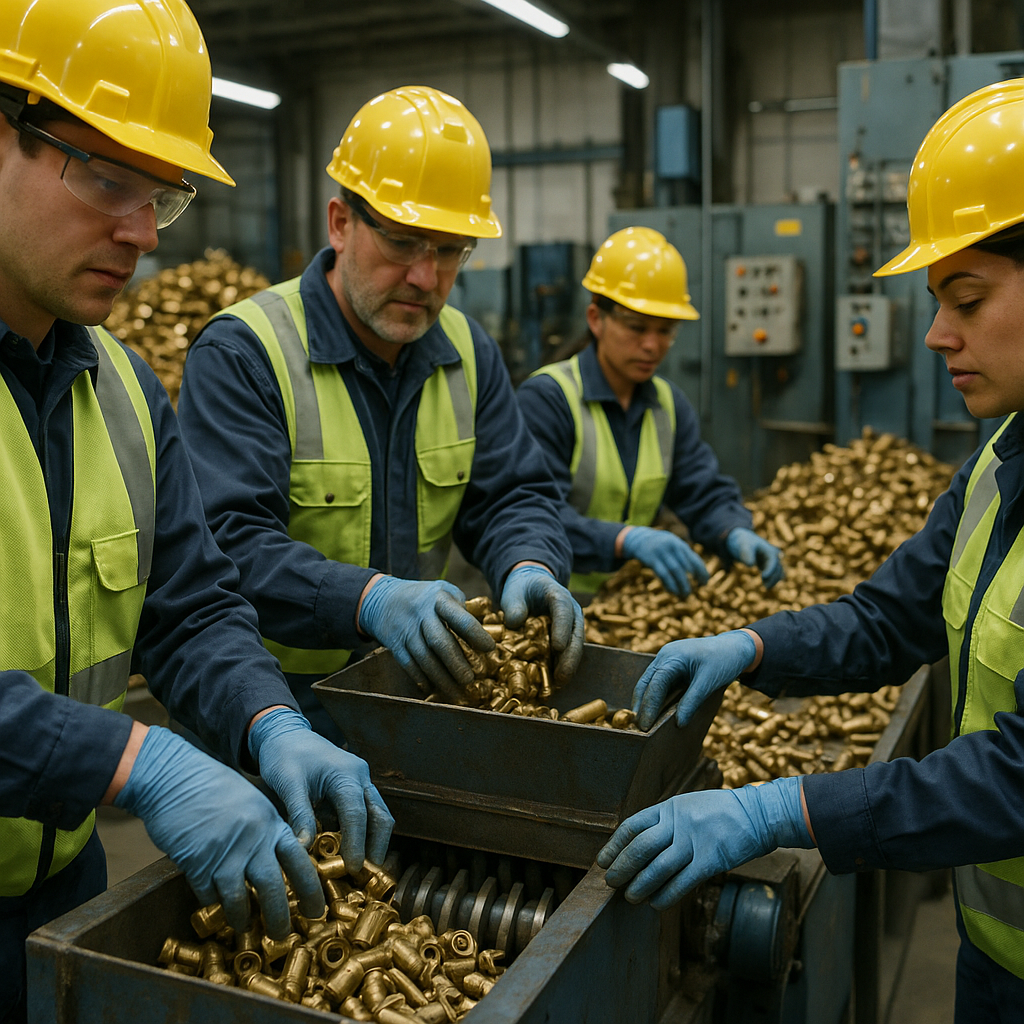5901 Botham Jean Blvd, Dallas, TX 75215
Scrap Brass Recycling: Types, Process, Environmental Benefits, and Economic Value
September 22, 2025Every day, numerous brass items reach the end of their useful life, such as that old faucet from your bathroom renovation, worn-out valves from industrial machinery, and spent shell casings from a shooting range. These items don’t need to end up in landfills. They can find new purpose through scrap brass recycling.
Scrap brass recycling involves collecting and reprocessing discarded brass materials to manufacture new products. Brass, an alloy primarily composed of copper and zinc in varying ratios, is commonly found in plumbing fixtures, musical instruments, ammunition casings, and decorative hardware in our homes and workplaces.
The recycling process transforms these unwanted items into valuable raw materials. Collection facilities sort and process the brass before it’s melted down and reformed into new products. This cycle preserves the metal’s properties without degradation. Unlike some materials that lose quality with each recycling cycle, brass can be reprocessed repeatedly without sacrificing performance.
What Types of Brass Can Be Recycled?

Most types of brass can be recycled, making it a versatile material in the recycling industry. The composition of brass typically determines its applications and recycling value. Understanding the different types of brass and their sources can help you maximize the value of your recyclable materials.
Common Types of Recyclable Brass
Each type of brass has distinct properties based on its copper-zinc ratio and any additional metals in the alloy. These variations create brass suited for specific uses.
Yellow brass is the most common type found in everyday items. With 60-70% copper and a distinctive golden color, this brass appears in plumbing fixtures, doorknobs, and keys. Its widespread use makes it a staple in recycling facilities.
Red brass, with over 80% copper, has a reddish or red-gold appearance, making it particularly valuable for recycling. You’ll find red brass in sprinkler heads, water pumps, plumbing tools, jewelry, meters, and some musical instruments like trombones.
Cartridge brass, also known as 260 brass or yellow brass, is composed of 70% copper and 30% zinc. Its malleability makes it ideal for shell casings, fasteners, electrical terminals, and locks. This brass type is highly recyclable due to its consistent composition.
Admiralty brass contains a small amount of tin, enhancing its corrosion resistance. This type is primarily used in marine applications and condenser tubes where durability in harsh conditions is essential.
Naval brass, similar to admiralty brass but with higher tin content, offers exceptional durability in marine environments. It is used in marine hardware, pump shafts, and valve stems. Its corrosion resistance and purity give it solid value in the recycling market.
Common Sources of Recyclable Brass
Knowing where to find brass for recycling can help you collect valuable materials that might otherwise end up in landfills.
Household items are one of the most accessible sources of recyclable brass. Look for old plumbing fixtures, faucets, doorknobs, and kitchenware. These common objects often contain significant amounts of recyclable brass.
Decorative items such as brass ornaments, plates, figurines, furniture accents, curtain rods, and garden decorations like birdbaths frequently contain brass. When these items are no longer usable, they become valuable recycling materials.
Electrical components including switches, connectors, and wiring often contain brass. These parts are particularly valued in recycling due to their high copper content and relatively pure composition.
Musical instruments, especially those in the brass family like trumpets, trombones, tubas, and French horns, are excellent sources of recyclable brass. Even when these instruments become unplayable, they retain significant recycling value.
Automotive parts such as radiators, valves, and fittings contain substantial amounts of brass. Vehicle manufacturers often prefer brass components for their durability and ability to withstand temperature variations better than alternatives.
Factors Affecting Recycling Value
The recycling value of brass depends on several key factors, such as processing costs and market demand.
Purity is a crucial factor. Cleaner, purer brass generally fetches higher prices because it requires less processing. Separating brass from contaminants like plastics, aluminum, or steel before recycling can significantly increase its value.
Copper content directly affects recycling value. Brass with higher copper percentages, like red brass, typically commands better prices due to copper’s inherent value and widespread industrial applications.
Market demand fluctuates based on manufacturing needs and economic conditions. When the demand for brass is high in manufacturing sectors, recycled brass prices tend to increase.
Quantity also matters. Larger amounts of brass generally receive better rates from recyclers due to economies of scale in processing and transportation.
How Does the Brass Recycling Process Work?

The brass recycling process transforms discarded brass items into valuable new products through a series of specialized steps. Each stage plays a vital role in recovering this durable alloy efficiently and sustainably.
Collection
The process starts with collection. Recycling facilities gather brass from various sources, including manufacturing scrap, construction waste, plumbing fixtures, and end-of-life products like valves and fittings. Contractors, plumbers, and demolition crews often contribute significant volumes of brass materials.
Some recycling centers offer pickup services for large industrial quantities, while smaller amounts can be dropped off directly at scrap yards. Upon arrival, the brass is weighed to determine its value based on current market rates.
Sorting and Inspection
Following collection, the brass undergoes thorough sorting. Workers separate brass from other metals and non-metal contaminants. This step is crucial for material purity and prevents contamination in later stages.
Brass is typically categorized into grades. Yellow brass, containing about 60-70% copper, differs from red brass (or gunmetal), which has up to 85% copper content and commands higher prices. Mixed brass with attachments like steel screws or plastic inserts receives lower valuations.
Skilled technicians inspect each batch for quality, as brass with excessive solder, oil, or other materials may require additional processing or face rejection.
Cleaning and Preparation
The sorted brass then moves to the cleaning stage. Contaminants such as dirt, grease, paint, and attached non-brass materials are removed. This essential step improves the purity of the final recycled product.
For larger pieces, the brass is cut into manageable sizes using specialized equipment. Clean, properly sized materials are processed more efficiently in subsequent stages and yield higher-quality recycled brass.
Shredding
Next is shredding, where brass items are broken down into small, uniform pieces. Industrial shredders transform the metal into fragments that will melt more efficiently.
Shredding reduces both the size and density of the brass, allowing for faster melting with less heat, saving energy, and improving the recycling process’s efficiency.
Melting
The shredded brass enters high-temperature furnaces where it is heated to over 1,600°F until it reaches a liquid state. The heating process may use natural gas or electricity depending on the facility.
During melting, impurities rise to the surface and can be skimmed off, which helps purify the molten brass before the next stage.
Purification
The molten brass undergoes rigorous quality control to ensure it meets industry standards. Various methods, including filtering, skimming, and chemical treatments, remove lingering contaminants.
Some facilities use electrolysis, which uses electric currents to dissolve impurities. Quality testing verifies the composition and purity, with samples analyzed for proper metal ratios and freedom from contaminants.
If quality standards are not met, the brass may require reprocessing through additional refining steps.
Casting
Once purified, the molten brass flows down a conveyor to a cooling chamber where it solidifies. The liquid metal is poured into molds to create specific forms like ingots, bars, or other shapes based on manufacturer requirements.
These standardized forms make the recycled brass easy to transport and integrate into new manufacturing processes. The casting process ensures consistent quality across batches.
Distribution and Reuse
The final recycled brass products are distributed to manufacturers who transform them into new items. From plumbing fixtures to musical instruments, decorative hardware to industrial components, recycled brass enters the market in numerous forms.
This completes the recycling loop, transforming brass from waste material back to a valuable resource. The entire process conserves natural resources, reduces energy consumption, and keeps valuable metals in circulation.
What Are the Environmental Benefits of Recycling Brass?

Recycling brass offers significant environmental benefits that extend far beyond waste reduction. By recycling brass instead of producing it from virgin materials, we engage in a sustainable cycle that supports ecological health in various ways.
Resource Conservation
Recycling brass conserves valuable natural resources. By reusing existing brass, we reduce the demand for new copper and zinc mining operations, which often lead to habitat destruction, deforestation, and ecological damage.
The conservation impact is substantial. Every ton of recycled brass minimizes disruption to natural landscapes and ecosystems that would otherwise be affected by extraction activities. Preserving these resources ensures their availability for future generations.
Brass can be recycled indefinitely without losing its essential properties. Unlike some materials that degrade during recycling, brass maintains its quality through multiple cycles, making it ideal for continuous reuse.
Energy Efficiency and Emissions Reduction
The energy savings from recycling brass are substantial. Processing recycled brass consumes up to 90% less energy compared to extracting and refining new materials, directly lowering greenhouse gas emissions.
The reduced energy consumption is primarily due to eliminating the need for intensive mining operations and high-temperature processing required to extract copper and zinc from ore. Recycling brass involves simply melting existing metal rather than converting ore into usable metal.
These energy savings significantly contribute to climate change mitigation. The brass recycling industry plays a crucial role in transitioning toward a more sustainable, low-carbon economy by reducing the carbon footprint associated with brass production.
Waste Reduction and Landfill Diversion
Brass does not degrade naturally in landfills. Discarded brass items occupy valuable landfill space indefinitely. By recycling brass, we keep these materials in productive use and out of waste management systems.
This diversion from landfills is crucial given the growing challenges of urban waste management. Every piece of recycled brass reduces pressure on existing landfill capacity and decreases the need for new waste disposal sites.
Toxicity Prevention
Proper brass recycling prevents potentially hazardous substances from contaminating ecosystems. Some brass alloys contain lead, cadmium, or other metals that can leach into soil and groundwater if improperly disposed of. Recycling ensures these materials are handled safely.
Recycling facilities provide a controlled environment for proper separation and management of harmful components in brass alloys. This approach minimizes the risk of environmental contamination, protecting both ecosystem health and human well-being.
By keeping these metals out of landfills and natural environments, recycling brass contributes to cleaner water systems, healthier soil, and reduced toxin accumulation in wildlife and plants.
Economic Sustainability
The environmental benefits of brass recycling extend to economic sustainability. Recycling stimulates the scrap metal industry, creating jobs in collection, processing, and transportation. This economic activity supports local communities while advancing environmental goals.
Additionally, recycling provides a more cost-effective source of brass for manufacturers. Reduced production costs can be passed on to consumers, making sustainable products more accessible and encouraging participation in recycling programs.
By combining environmental protection with economic advantages, brass recycling exemplifies how sustainability practices can align with business interests to create viable long-term solutions.
What Are the Economic Advantages of Brass Recycling?

Brass recycling generates significant economic value across various sectors. Manufacturers benefit from a cost-effective raw material source that requires less processing and energy than virgin materials. Recycled brass can cost 30-40% less than newly mined and processed brass while maintaining identical physical and chemical properties.
For individuals and businesses, brass recycling offers a direct revenue opportunity. Scrap yards typically pay competitive rates for brass, with prices varying based on the type and quality of brass being recycled. Clean brass without contaminants fetches higher prices, encouraging proper sorting and preparation.
Small business owners and individuals can collect items such as plumbing fixtures, doorknobs, musical instruments, and ammunition casings. These common household and commercial items contain valuable brass that can generate supplemental income when recycled rather than discarded.
The brass recycling industry supports substantial job creation throughout the supply chain. From collection and transportation to processing facilities and manufacturing operations, the industry employs workers at various skill levels. These jobs contribute to local economic development, especially in communities with active recycling centers.
The economic efficiency of brass recycling is notable. Brass scraps can be reclaimed for 75-85% of their original value, offsetting the initial material costs. This high reclamation value creates an advantageous total cost structure for businesses compared to alternative materials, even when the initial purchase price is higher.
For manufacturers, the machinability of brass further enhances its economic appeal. Brass components typically require less production time than steel alternatives, reducing labor and operational costs. In one real-world manufacturing comparison, finished parts made from free-cutting brass cost 37% less than comparable leaded steel parts when considering total production expenses.
The entire brass industry depends on the circular flow of recycled materials. This economic model allows manufacturers to use the most suitable and cost-effective feedstock for specific applications, optimizing production costs while maintaining product quality. The result is a self-sustaining system where recycling directly supports economic viability.
Local Economic Impact
Communities with recycling facilities benefit from direct employment and indirect economic activity. These operations stimulate local spending, support auxiliary businesses, and contribute to the tax base. The presence of metal recycling centers often becomes integral to local industrial ecosystems.
Businesses that implement brass recycling programs also enjoy operational efficiencies. Regular recycling helps maintain clean, organized workspaces free of clutter, which can enhance overall productivity and workplace safety. The combination of revenue generation and operational improvements creates a compelling business case for brass recycling.
Municipal governments and regional authorities increasingly recognize the economic value of recycling infrastructure. Many have implemented incentives and support programs to encourage business participation in metal recycling efforts, further enhancing the financial benefits available to participating organizations.
Conclusion: The Importance of Scrap Brass Recycling

Scrap brass recycling is crucial for promoting environmental sustainability and economic growth. By recycling brass, we conserve valuable natural resources, reducing the necessity for mining raw copper and zinc. Every piece of recycled brass means lower energy consumption, fewer greenhouse gas emissions, and less pollution of our air and water resources.
The economic benefits of brass recycling are equally important. The industry generates thousands of jobs across collection, processing, and manufacturing sectors while offering financial incentives for individuals and businesses that participate. These benefits spread through communities, bolstering local economies and fostering a more sustainable circular economy where materials remain in use indefinitely.
For your recycling needs, contact Okon Recycling at 214-717-4083. Our team can help you transform your scrap brass into value, contributing to a greener, more sustainable future.
